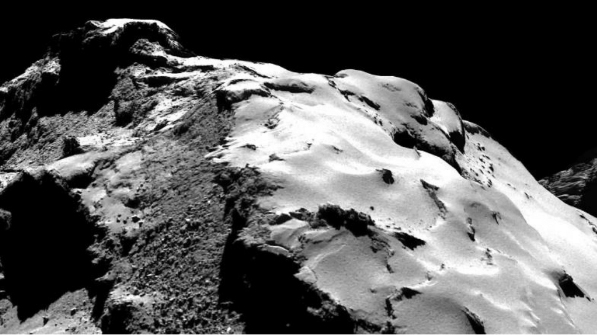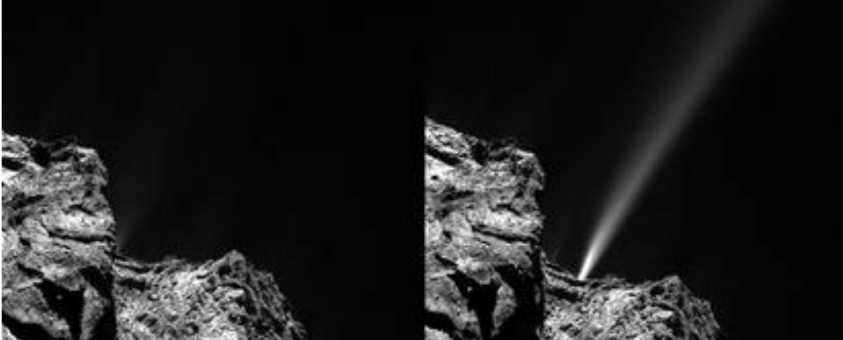
Asteroids Ahoy
Asteroids Ahoy! – or may be that should be ‘Land - Ho!’
The JAXA (Japanese Space Agency) asteroid probeHayabusa-2 has arrived at its target, Near-Earth Asteroid 1999 RQ36 Ryugu.It has succeeded in returning beautiful images, has landed 3 surface probes, has blasted a crater, and has sampled the uncovered pristine material. The project has so far been a ‘tour-de-force’ for the Japanese, crowning them as asteroid explorers without peer. NASA’s Osiris-Rex has also arrived at its target, 1999 JU3 Bennu.
nb, this para is severely dated: Hayabusa-2 has completed its at-asteroid mission and is now on the way home, timetabled to return to Earth (touching down within the Woomera Rocket Range in Sth Australia) in early December..
Like all previous asteroid flybys and rendezvous missions, again we are finding a bunch of real surprises, and some ‘WTF?’ discoveries.
The very first asteroid flybys were of Main Belt S-type asteroids Gaspra (18 x 10 x 9km) and Ida (60 x 25 x 19km), by the Galileo probe, outbound to Jupiter, in Oct 1991 and August 1993 respectively. At that time, there was a general belief that all small asteroids would probably be essentially sandblasted monolithic rocks, like slabs blasted from a basalt quarry, with any small particles having been blasted free by micrometeorite bombardment .And indeed the overall shape of Gaspra was found to be a faceted shard.

But imagine the surprise when the first Gaspra pictures came back, showing as well, that the surface was saturated with craters, in an obvious deep loose regolith! There were even clear landslips visible in some crater walls.. Then the Ida images, again with an obvious deep developed regolith and–what’s this?–a satellite, a little moon, previously thought quite unlikely, ‘cos goodness me, if there is to be a collision powerful enough to eject a fragment, then surely that fragment will totally escape, off into its own heliocentric orbit??


Then the Mathilde (C-class, Main Belt, ca. 50 km diameter) fly by, by the NEAR-Shoemaker probe in 1997, outbound to Eros, captured images of those massive craters, nearly the size of the asteroid itself. How could it be that these impacts didn’t completely disrupt the asteroid? Is seems it had to do with the other big surprise, found by observing the deflection of the trajectory of NEAR as it passed, namely the very low density (= 1.3 t/m3), which in turn implied very high porosity: this porosity evidently provided a shock-absorber effect which dampened the effect of the impacts that blasted out the mega-craters.
Then when NEAR-Shoe maker first flew by (1998), then arrived at Eros in 2000 (elongate sweet-potato shape, 34 x 11 x 11 km) it found a surface that again was crater-saturated, again with a thick regolith; some craters contained small flat dust-ponds.. What might have caused them? Ideas floated (pun intended) include seismic shaking, electrostatic levitation, and fluidization by episodic release of deep volatiles.


More recent targets continue to puzzle / stun / intrigue:
Hayabusa-1 arrived at NEA Itokawa in 2005, and found it to be a small (500m long) peanut shaped, very low density (=1.9 t/m3) S-class object, covered with regions dense with boulders and rubble,and other areas smooth with coarse gravel, but hardly any craters. Such low density implies a very high porosity. This together with the shape, which implies a contact binary, and the cover of massive boulders, suggests the object fits the classic ‘rubble pile’ model.


Here, Lutetia, imaged by Rosetta spacecraft enroute to comet 67P Churyumov-Gerasimenko, is a Main Belt Asteroid, approx. 100 km diameter, probably stony-iron object, with a thick regolith.
Toutatis, below, a NEA and PHA, imaged by the re-purposed Chinese Lunar probe Chang’e-2, is a contact binary, 4.75 x 2.5 x 2 km. Neck infilled with loose rubble. Craters and prominent huge boulders. Does a close-ish flyby of Earth every 4 yrs.

Space probes to comets have been similarly packed with surprise and puzzlements:
Giotto to 1P/ Halley: closest approach 600 km, 1986: the surprise was the degree of localization of individual active jets (and the complex multi-lobate morphology)

Deep Space 1 to 19P/ Borrelly in 2001. A secondary target ultimately discarded due to operational constraints was Wilson-Harrington which would have been very interesting as it is thought to be a transitional object evolving into an asteroid)
.

Deep Impact to 9P/Tempel2 and 103P/Hartley:

The impactor hit at 10 km/s, giving an explosion equivalent to several tonnes of high explosive, it excavated a crater about 150 metres diam and 30 metres deep (much bigger than expected). Discoveries: unexpectedly, much more dust than ice; apart from water, it found silicates, carbonates, clays, sulphides, amorphous carbon, and aromatic carbon compounds.
103P/Hartley:Deep Impact mission extended, renamed EPOXi:

Discovery: very active ejection of dust plus lump sand grains of ice is being driven by sublimation of CO2 in the warming interior. CO2 emits from the ends, water vapour from the ‘waist’, which is thought to be cloaked with redeposited fines
Stardust to 81P/ Wild2 and 9P/Tempel2:

Of interest, note the ‘square-bottomed’ depressions, seen also on Tempel 2, and later on 67P. These are obviously not impact craters but ‘something else’. Stardust returned dust to Earth for assay: found a range of organic carbon compounds, plus various non-hydrous silicates.

Stardust re-visited Tempel 2 so as to image the crater formed when Deep Impact impactor struck.
Rosetta to 67P/ Churyumov-Gerasimenko:
What’s not to like about 67P? -starting with the ‘bath-tub duck’ shape…

The surprises were many: cliffs, some seen to collapse during active perihelion phase, layers showing significant strength variations; as on other comets, lots of large square-section holes, now hypothesized to be like dolines or sinkholes, due to subsurface mass loss and undercutting followed by collapse; and dune fields such as one would expect in a desert(!!)–how can one get aeolian features on an airless body??



So, now on to Ryugu and Bennu :
Both are Near Earth Asteroids (NEAs) and ‘Potentially Hazardous Asteroids’(PHAs)
Ryugu is a 900 m diameter C-class Apollo; Q = 1.4 AU, q = 0.96 AU, i = 5.9°; spin period is 7.6 hrs; density 1.2 g/cc; albedo 0.07; surface regolith was predicted to show grain size 1 to 10 mm (ie, ‘fine gravel’).
Bennu is a 500 m diameter B-class Apollo and PHA; Q = 1.35 AU, q = 0.89 AU, i = 5°; spin period 4.3hrs; density 1.26g/cc, based on observed Yarkovsky acceleration and guesstimated volume(suggesting high macroporosity, like Mathilde); albedo 0.046; grain size several mm.
These are both right in the ballpark of my selection criteria for mineable targets.
Well, surprise, surprise! The surface of both is covered with rocks and massive boulders! Hardly anywhere to land your spacecraft.
Both have a prominent equatorial bulge, which is interpreted as relict of an earlier era of faster spin.
Both are pretty unequivocally ‘rubble piles’, and the presence of the massive boulders, and areas of imbricated boulders, both indicate massive churning or gardening or collisional disaggregation and re-accretion, and slumping, such that the bodies have to be regarded as thoroughly mixed, at a largescale, throughout.
Below are the first resolved Ryugu images as of 22 June 2018:

Note the equatorial bulge, the big craters, the lots ofvery big boulders, and the slightly higher albedo of the equatorial belt… and something weird at the north pole.The rotation axis is pretty much orthogonal to the plane of the ecliptic, but the rotation is retrograde (backwards, clockwise instead of anticlockwise, i.e., it’s really the south pole..)

Note, nearly all other small asteroids / comets have turned out not to have been ‘near-spherical’. This is a hint, of what?
And, what’s with the bright feature near the pole?–Is it salt deposits (like on Ceres)??
To give an even better view, here are the latest stereo pictures of Ryugu, from opposite sides:


Lorem ipsum dolor sit amet, consectetur adipiscing elit. Ut elit tellus, luctus nec ullamcorper mattis, pulvinar dapibus leo.

Bennu is similarly surprising: the equatorial bulge had been predicted, but not the massive boulders. Spectral info shows ubiquitous water of hydration signal, and much more clearly than for Ryugu, at ca 55% of surface coverage, with suggested bulk composition maybe ca 5% water chemically bound, by mass.
,
What did I want to see, from a ‘resource perspective’?
- Images indicating relatively well developed but not too heavily gardened regolith. What we found: very coarse material and large boulders.
- Regolith images and other data indicating grain sizes in the mm range or less. The fines between and surrounding boulders wa indeed in the mm to cm range.
- Indications via spectra of water-bearing materials such as clays and hydrated salts. -yes, widespread, but not as prominent as expected.
- Surface topography images which can be interpreted to infer compressive and / or tensile strength (cliffs, sinkholes, etc).-yes, indications are ‘weakly cohesive’.